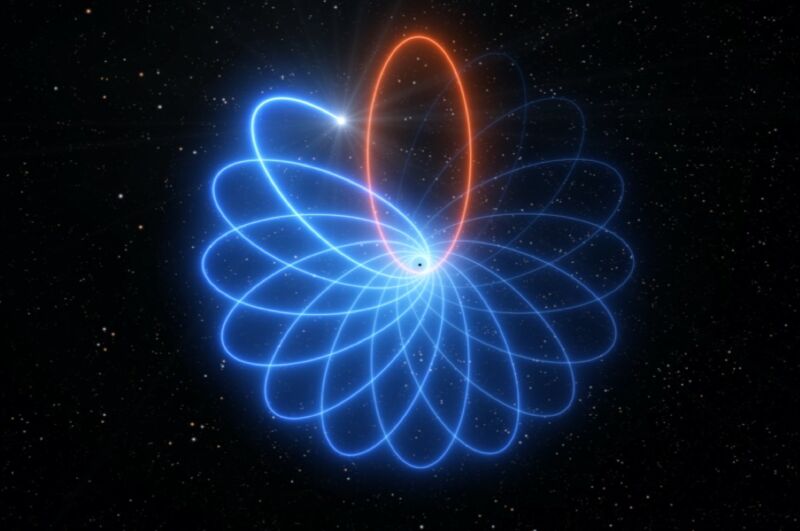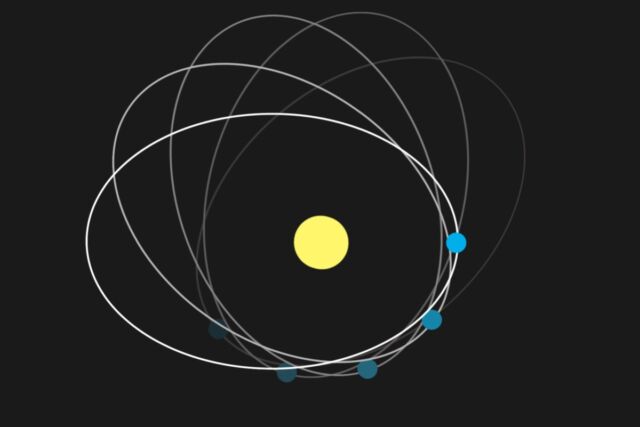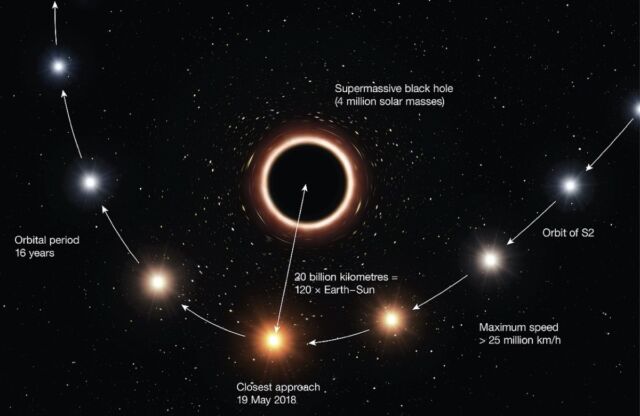
It's been nearly 30 years in the making, but scientists with the Very Large Telescope (VLT) collaboration in the Atacama Desert in Chile have now measured, for the very first time, the unique orbit of a star orbiting the supermassive black hole believed to lie at the center of our Milky Way galaxy. The path of the star (known as S2) traces a distinctive rosette-shaped pattern (similar to a spirograph), in keeping with one of the central predictions of Albert Einstein's general theory of relativity. The international collaboration described their results in a new paper in the journal Astronomy and Astrophysics.
“General relativity predicts that bound orbits of one object around another are not closed, as in Newtonian gravity, but precess forwards in the plane of motion," said Reinhard Genzel, director at the Max Planck Institute for Extraterrestrial Physics (MPE) in Garching, Germany. "This famous effect—first seen in the orbit of the planet Mercury around the Sun—was the first evidence in favor of general relativity. One hundred years later we have now detected the same effect in the motion of a star orbiting the compact radio source Sagittarius A* (SagA*) at the center of the Milky Way."
When Einstein developed his general theory of relativity, he proposed three classical tests to confirm its validity. One was the deflection of light by the Sun. Since massive objects warp and curve spacetime, light will follow a curved path around massive objects. This prediction was confirmed in 1919 with that year's solar eclipse, thanks to Sir Arthur Eddington's expedition to measure the gravitational deflection of starlight passing near the Sun. The confirmation made headlines around the world, and Einstein became a household name.

General relativity also predicted a gravitational redshift of light in the presence of strong gravitational fields. That was first confirmed with the measurement of a redshift in the starlight of a white dwarf star in 1954.
The third test was the precession of Mercury's rather eccentric elliptical orbit around the Sun. Every 100 years or so, the planet's perihelion, or the point where it is closest to the Sun, drifts about 0.001 degrees, thanks to the gravitational pull of other planets. That effect is how astronomers eventually discovered Neptune. Astronomers had noticed some odd perturbations in the orbit of Uranus, and 19th-century French mathematician Urbain Le Verrier correctly deduced it was evidence for another planet; his 1845 prediction was observationally confirmed in September 1846.
Le Verrier also attempted to model Mercury's orbit in accordance with Newtonian gravity, which was put to the test during the 1843 transit of Mercury. His model failed that test, and he suggested that, once again, the deviations might be due to a hypothetical as-yet-undiscovered planet even closer to the Sun, subsequently dubbed Vulcan. But over the ensuing decades, no confirmed observations of such a planet transpired. It was Einstein who showed that the Newtonian theory of gravity was incomplete. General relativity accounts precisely for the observed precession of Mercury's orbit.

If those key predictions of general relativity have already been experimentally confirmed, why are scientists so keen to keep on testing them? Well, there may be unique environments beyond our solar system—say, the extreme gravity of a supermassive black hole—where the laws of physics might not be quite the same. SagA* is the perfect laboratory to study this, especially given the dense cluster of stars orbiting around it. One of those stars, S2, holds particular interest, since it comes quite near the black hole during its closest approach (less than 20 billion kilometers).
Enter the folks behind the VLT, which first came online in 1998. The VLT team was able to detect the faint glow around the black hole as S2 passed by in its first observations of the star. About two years later, in 2018, they successfully measured S2's gravitational redshift, whereby the strong gravity of the black hole stretches the star's light to longer wavelengths as it passes. Infrared observations—using the VLT's GRAVITY, SINFONIA, and NACO instruments—showed that how much the light is shifted matched precisely with the predictions of general relativity.
Like the redshift effect, the precession of S2's orbit is tiny, meaning it requires longer observation times before astronomers can detect them. S2 completes an orbit once every 16 years. The team finally collected enough data points on the star's position and velocity—over 330 measurements in all—to precisely map out its orbit. And just as general relativity predicts, each time S2 passes close to the supermassive black hole, it gets a gravitational "kick," changing its orbit ever so slightly, so the orbital path forms that pretty rosette shape.

"Our previous result has shown that the light emitted from the star experiences General Relativity. Now we have shown that the star itself senses the effects of general relativity," said Paulo Garcia of Portugal’s Centre for Astrophysics and Gravitation, one of the lead scientists on GRAVITY.
The next phase will rely on the forthcoming Extremely Large Telescope, which should give scientists the ability to see much fainter stars near the supermassive black hole. "If we are lucky, we might capture stars close enough that they actually feel the rotation, the spin, of the black hole," said Cologne University's Andreas Eckart, another lead scientist of the project, thereby enabling astronomers to measure SagA*'s spin and mass as well as define space and time around it. "That would be again a completely different level of testing relativity."
DOI: Astronomy and Astrophysics, 2020. 10.1051/0004-6361/202037813 (About DOIs).
https://news.google.com/__i/rss/rd/articles/CBMicmh0dHBzOi8vYXJzdGVjaG5pY2EuY29tL3NjaWVuY2UvMjAyMC8wNC9zdGFyLWRhbmNpbmctYXJvdW5kLWEtc3VwZXJtYXNzaXZlLWJsYWNrLWhvbGUtY29uZmlybXMtZWluc3RlaW4teWV0LWFnYWluL9IBeGh0dHBzOi8vYXJzdGVjaG5pY2EuY29tL3NjaWVuY2UvMjAyMC8wNC9zdGFyLWRhbmNpbmctYXJvdW5kLWEtc3VwZXJtYXNzaXZlLWJsYWNrLWhvbGUtY29uZmlybXMtZWluc3RlaW4teWV0LWFnYWluLz9hbXA9MQ?oc=5
2020-04-16 21:15:00Z
52780730229743
Tidak ada komentar:
Posting Komentar